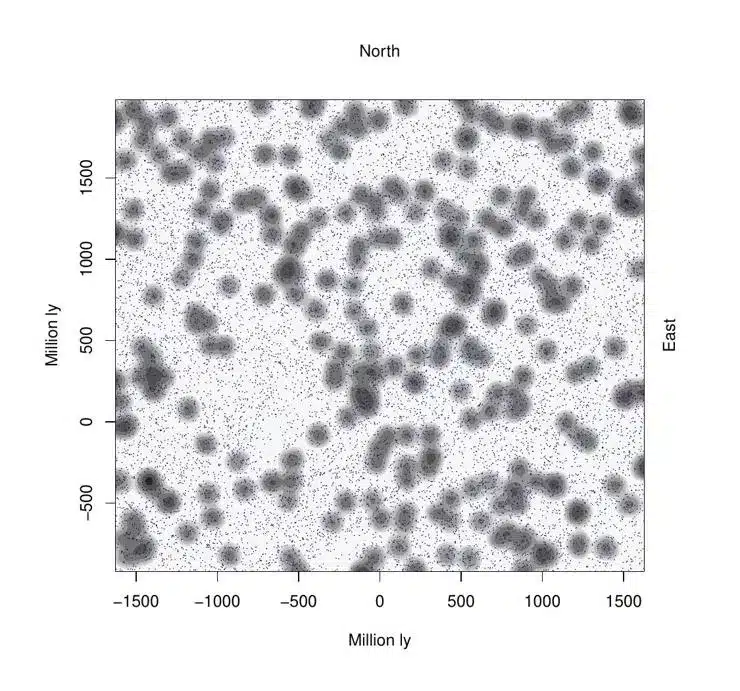The recent discovery of a second ultra-large structure in the distant universe is challenging some fundamental assumptions in cosmology. Known as the Big Ring of the Sky, it is located 9.2 billion light-years from Earth, featuring a diameter of approximately 1.3 billion light-years and a circumference of about four billion light-years.
It would take about 15 full Moons to cover its diameter if visible. This marks the second ultra-large structure found by University of Central Lancashire (UCLan) PhD student Alexia Lopez, who had previously discovered the Giant Arc on the Sky, measuring 3.3 billion light-years across.
Notably, the Big Ring and the Giant Arc share the same cosmological neighborhood, observed at the same distance and cosmic time, with only 12 degrees separating them in the Sky.
Alexia said, “Neither of these two ultra-large structures is easy to explain in our current understanding of the universe. And their ultra-large sizes, distinctive shapes, and cosmological proximity must surely be telling us something important – but what exactly?”
“One possibility is that the Big Ring could be related to Baryonic Acoustic Oscillations (BAOs). BAOs arise from oscillations in the early universe and should appear statistically as spherical shells in the arrangement of galaxies today. However, detailed analysis of the Big Ring revealed it is not compatible with the BAO explanation: it is too large and not spherical.”
The discovery of structures like the Big Ring on the Sky challenges standard cosmological assumptions, suggesting alternative explanations are needed. One such possibility is a different cosmological theory, called Conformal Cyclic Cosmology (CCC), proposed by Nobel laureate Sir Roger Penrose. Rings in the universe may serve as a signal supporting the principles of CCC.
An alternative explanation for the observed structures, like the Big Ring on the Sky, could involve the influence of cosmic strings passing through. These cosmic strings are large, filamentary “topological defects” that might have originated in the early universe. Nobel laureate Jim Peebles has recently suggested that cosmic strings could explain certain peculiarities in the large-scale distribution of galaxies.
Moreover, the Big Ring raises questions about the Cosmological Principle, which the previously discovered Giant Arc similarly challenged. If the Big Ring and the Giant Arc contribute to an even larger structure, the challenge to the Cosmological Principle becomes more compelling.
Discoveries of such large structures, including those made by other cosmologists, defy our conventional understanding of what an ‘average’ region of space looks like. They surpass the theoretically accepted size limits and pose potential challenges to the Cosmological Principle.
Alexia said: “The Cosmological Principle assumes that the part of the universe we can see is viewed as a ‘fair sample’ of what we expect the rest of the universe to be like. We expect matter to be evenly distributed everywhere in space when we view the universe on a large scale, so there should be no noticeable irregularities above a specific size.
“Cosmologists calculate the current theoretical size limit of structures to be 1.2 billion light-years, yet both systems are much more significant – the Giant Arc is almost three times bigger, and the Big Ring’s circumference is comparable to the Giant Arc’s length.
“From current cosmological theories, we didn’t think structures on this scale were possible. We could expect maybe one exceedingly large structure in all our observable universe. Yet, the Big Ring and the Giant Arc are two huge structures and are even cosmological neighbours, which is extraordinarily fascinating.”
While the Big Ring initially appears as an almost perfect ring in the Sky, further analysis by Alexia Lopez indicates that it has more of a coil shape, resembling a cork-screw aligned face-on with Earth. On the other hand, the Giant Arc, which is approximately 1/15th the radius of the observable universe, manifests as an enormous, nearly symmetrical crescent of galaxies in the distant universe. Remarkably, it is twice the size of the Sloan Great Wall of galaxies and clusters observed in the relatively nearby universe.


Alexia said, “The Big Ring and Giant Arc are the same distance from us, near the constellation of Boötes the Herdsman, meaning they existed at the same cosmic time when the universe was only half its present age. They are also in the same region of Sky, at only 12 degrees apart when observing the night sky.”
“Identifying two extraordinary ultra-large structures in such close configuration raises the possibility that together they form an even more extraordinary cosmological system.”
“This data we’re looking at is so far away that it has taken half the universe’s life to get to us, from when the universe was about 1.8 times smaller than it is now. The Big Ring and the Giant Arc, both individually and together, give us a big cosmological mystery as we work to understand the universe and its development.”
Scientists discovered the new structure by looking at absorption lines in the spectra of quasars from the Sloan Digital Sky Survey (SDSS).
Using the same method that led to the discovery of the Giant Arc, they observed the intervening Magnesium-II (or MgII – it means the atom has lost an electron) absorption systems back-lit by quasars, which are remote super-luminous galaxies. These very-distant, very bright quasars act like giant lamps shining a spotlight through distant but much fainter, intervening galaxies that otherwise would go unseen.
The findings are presented on the Big Ring at the 243rd American Astronomical Society (AAS) meeting on the 10 January.